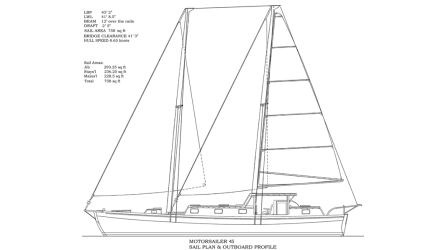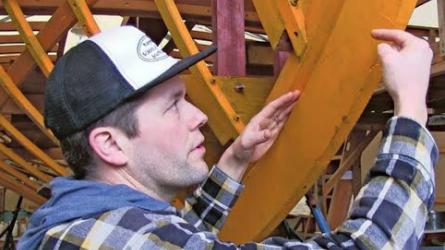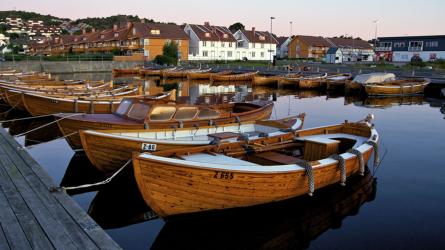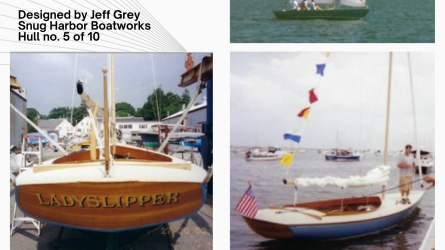Choosing Anchors And Rodes
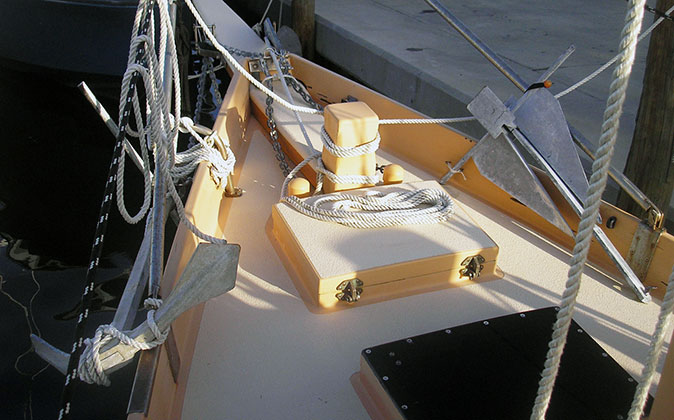
For over 35 years I have lived, on and off, as a cruising sailor. In addition to designing, building and restoring wooden boats, this has been my life. In all those years, I have learned a lot, and made a lot of observations. Cruisers are in some ways a huge community, spanning oceans and borders, as well as lifestyles and economies. So there is overlap, a great exchange of information, and mutual learning experiences.
There are as many types of cruisers as there are people and boats. We are a very diverse group, in every way imaginable. But some things tie us together, because we all have to deal with them: Like anchoring.

The schooner IBIS’ anchor configuration—#1 Bower is the 35 lb Delta plow top center, in the starboard bow roller; the 55 lb Herreshoff is rigged over the port bow roller for anchoring in the Bahamas; and the 25 lb Danforth is lashed to the starboard bulwarks; Note the small cathead on the port bulwark, the PVC deck pipes, and the chain-grabbers above the bowsprit. IBIS’ anchors are small for a 45′ schooner because her displacement is only 14,500 lbs. No windlass is required for her, and I have a bad back!
Among my observations are the way different people go about anchoring, starting with how they equip their boats. What I have seen is that many mariners—particularly those new to cruising—have grossly inadequate ground tackle.
Of the dozens of books I read as part of my nautical education, perhaps the single most valuable one was Oceanography and Seamanship, by William G. Van Dorn. This became my nautical bible for how strong to make things, and how to survive when it comes right down to survival conditions. Van Dorn’s book spelled out very clearly how to choose and size your rigging, ground tackle, and how to equip your boat for her intended uses—including preparing for worst case scenarios. What I learned from his book became the foundation of my own beliefs and practices—his principles were soundly confirmed by my experiences.
So, both as a cruising sailor, and as a marine architect and shipwright, I present here my own opinions of how to equip an ocean cruising sailboat with proper ground tackle.
First, anchor and rode size is determined by boat displacement, hull type, and rig more than by boat length. This should be obvious, but I constantly see ground tackle being determined by boat length, which is a less-critical factor. Displacement equals weight. A heavy boat is going to require larger anchors than a light one of equal length. Hull type involves factors like draft, beam, prismatic coefficient, and motion predicted by those factors. A hull that “searches” constantly, veering side to side and exposing her topsides to wind, is in danger of working her anchor loose. Likewise, a hull that pitches strongly in modest waves is more prone to working her anchor free. Both types are harder on their rodes and rollers, and are more prone to chafe. Rig determines windage. A tall modern rig with lots of standing rigging is going to have much more windage than a traditional type with low, free-standing masts. Roller furling jibs have much more windage than bare forestays, and are vulnerable to unfurling in strong winds. Even partial unfurling, or the upper part of a jib coming loose, can cause a disaster. I have seen this every time a hurricane sweeps the boatyard.
I firmly believe all cruising boats should carry a minimum of three anchors, and long-range cruisers should carry four, plus a backup for #1 bower, stored below. Following are my recommendations:
- NUMBER ONE BOWER: This should be a plow-type. CQR is the best, the Lewmar Delta is very good, and some of the Chinese imitations are good (LEOPARD used an ABI 105 lb plow). There are many new types of anchors on the market—some very good—some highly questionable. The Bruce anchor is commonly used with success; but the Chinese imitation (the Claw) just doesn’t set well in any firm bottom; I used one for a year, with constant failures, and gave it up in frustration. I also used a Max anchor for a season, and found it unsatisfactory as well as unwieldy. Use lots of chain—or all chain—for your primary anchor. Always install a heavy-duty swivel between anchor and chain.
- NUMBER TWO BOWER: This depends on cruising ground. When anchoring in soft sand or mud, the Danforth-type is hard to beat. BUT—if pulled upon from different directions, it tends to trip, foul and drag. It is no good used alone in a tidal anchorage, for example. The plow, on the other hand, rarely trips when pulled from even the opposite direction. Also, the Danforth will not set or hold in kelp or heavy grass. The plow may not hold in kelp either. Use some chain spliced to 3-strand nylon.
- NUMBER THREE BOWER: This should be the fisherman-type, used as determined by bottom conditions. When anchoring on a hard, smooth bottom or in kelp, the fisherman or Herreshoff types cannot be beat. No other anchor will hold reliably in smooth rock, hard marl/sandstone, or “scoured out” (hard and smooth) bottoms. We cruisers refer to this kind of bottom as “Teflon”. The only time I have ever seen a fisherman fail is when the rode gets wrapped around the upper fluke, and trips the anchor. This anchor may use the same rode as the #2 bower, as few vessels have rollers or hawses for more than two anchors. Remember to seize the shackles when changing anchors!
- STERN KEDGE: I always use a Danforth-type for my stern kedge, typically one size smaller than my #2 bower. A stern kedge is used to hold the stern away from a dock when moored “Mediterranean” style, and when anchored off a beach with the bow tied to a palm tree. It is also used to hold the stern in a fixed position, such as in tidal anchorages where currents are moderate and winds mild. Obviously, anchoring the stern of a vessel into wind and current is a bad idea. The kedge should be small and light enough to be carried out and deployed from your dinghy. Do not use Danforth types when anchoring in rocky bottoms; if only one fluke catches, the anchor will bend in half and fail!
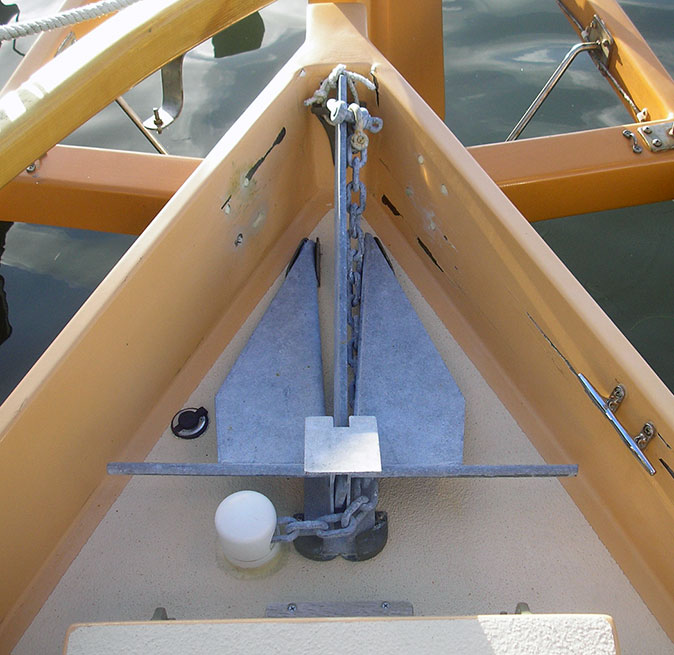
IBIS’ stern kedge mounted in bronze deck fittings—note the chain and PVC deck pipe.
I use a short piece of chain with my stern kedge (10-feet or less), spliced to a 3-strand nylon anchor rode. Chain and rode are led through a deck pipe and coiled into a 5-gallon bucket in the lazarette. When anchoring in a tidal anchorage, I drop the bow anchor, fall back to twice the desired scope, drop the stern kedge, and carry the bucket forward, paying out scope for the kedge. I then pull in scope on the bow anchor and make off the stern kedge to the mooring bitt forward. When the tide turns, the boat swings 180 degrees and rides to the kedge. Bahamian anchorages are frequently tidal.
I use 5/16″ Proof-coil or BBB chain spliced to ½″ 3-strand nylon for vessels under 15,000 lbs displacement. Above that, up to 40,000 lbs displacement, I use 3/8″ chain spliced to 5/8″ nylon. Avoid Hi-tensile chain, as it has high carbon content and will not last as long. Splice the nylon to the last link of chain over a small piece of leather. The splice will not jamb in the deck pipe or get stuck on the roller, both of which can cause a disaster. Never shackle chain to an eye splice over a thimble—the thimble will cock in the stretchy nylon and cut it in half. Use chafe gear where the nylon rode is vulnerable.
As most cruisers know, the “scope” they should use when anchoring is at least 5 to 1. This means for every 10’ of depth (bottom to bow roller), you should deploy 50’ of anchor rode. But if conditions indicate it, less or more rode may be deployed. In a quiet, well-protected anchorage which is also crowded, you may anchor with 5::1 rode, back down to set your anchor, then shorten scope to decrease your radius of swing (the circle your boat describes at anchor). And of course as conditions deteriorate, or if you are anchored in poor holding, you should deploy more scope.
Even though few people do it, you should dive on your anchor to confirm that it is well set; or at least get above it and look at it, either in snorkel gear or in your dinghy with a “sight bucket” (glass-bottom device for seeing under water).
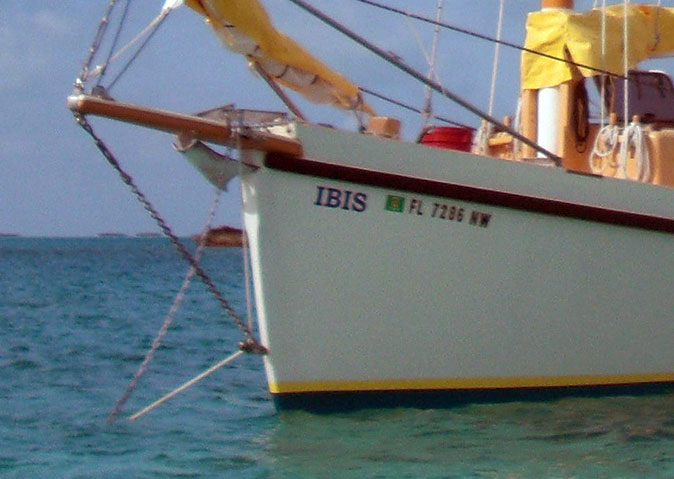
IBIS’ nylon anchor lizard attached to the chain rode with a chain hook; the anchor in the starboard roller is a “Max” I found in the dumpster in the boatyard; after trying it for a season I returned it to the dumpster
I always use an anchor lizard or snubber. This consists of a heavy-duty stainless steel block shackled to the bobstay chain plate, through which is led a nylon snubber. Use a chain hook to grab your primary anchor rode—this shifts the scope angle from your bow roller down to the cutwater, and decreases the amount of rode paid out to achieve a 5 to 1 scope ratio. It also prevents the anchor rode from chafing or rubbing against the bobstay (chain-to-chain makes a hell of a racket). The lizard is led from the cutwater block up to the bow roller, thence to the mooring bitt. It should be about 40-feet long, so that you can pay out more scope if the wind picks up, but you can always add additional rode if necessary.
In later blogs I will try to write about anchor rollers and windlasses.
3/3/2014, St. Lucie Village
